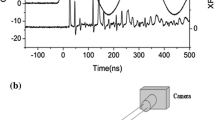Summary
The construction and the operating characteristics of a X-ray preionized discharge XeCl laser are described. A specific laser output energy of 3.3 J/l with a pulsewidth of 150 ns and a spatial beam uniformity better than 90% in a (3.5×3.5) cm2 cross-section was achieved. Intrinsic efficiency up to 3.6% has been obtained without the use of an external prepulse circuit. A fast, high-voltage prepulse to intensify the preionization has been successfully tried out, obtaining a better energy coupling to the gas and more reliable conditions at lower working voltage.
Riassunto
Si presentano le caratteristiche costruttive e operative di un laser a XeCl preionizzato a raggi X e funzionante in regime di scarica autosostenuta. Si sono ottenuti impulsi laser con energie specifiche di 3.3 J/l e durata di 150 ns. L’uniformità spaziale del fascio laser di dimensioni (3.5×3.5) cm2 è risultata migliore del 90%. La massima efficienza intrinseca raggiunta senza l’uso di un circuito esterno di preimpulso è stata del 3.6%. L’introduzione del preimpulso ad alta tensione per intensificare la preionizzazione ha consentito di migliorare l’accoppiamento in energia depositata nel mezzo attivo e di ottenere un punto di lavoro piú stabile a tensione di pompaggio piú bassa.
Резюме
Описываются конструкция и характеристики рентгеновского предионизационного XeCl лазера. Были получены лазерные импульсы с удельной энергией 3.3 Дж/литр и длительностью 150 нс. Пространственная однородность лазерного пучка с размерами (3.5×3.5) см2 была лучше 90%. Была получена внутренняя эффективность вплоть до 3.6% без использования внешнего предимпульсного тока. Успешно опробовано введение предимпульса высокого напряжения для интенсификации предионизации. Получено улучшение связи энергии в активной среде и более надежные условия работы лазера при меньшем напряжении.
Similar content being viewed by others
References
E. Fiorentino, T. Letardi andA. Marino:Nuovo Cimento B,71, 205 (1982).
E. Fiorentino, T. Letardi, A. Marino, E. Sabia andM. Vannini:Laser Part. Beams,3, 319 (1985).
A. De Angelis, E. Fiorentino, G. Giordano, T. Letardi, E. Sabia andM. Vannini:High uniformity X-ray preionized discharge XeCl laser, inProceedings of the International Conference on Lasers 84, edited byK. M. Corcoran, D. M. Sullivan andW. C. Stwalley (STS Press, McLean, VA, 1985), p. 606.
K. Midorikawa, M. Obara andT. Fujioka:IEEE J. Quantum Electron., QE-20, 198 (1984).
Silice Optique: Electro Quartz Data Sheet.
As pointed out in ref. (4)K. Midorikawa, M. Obara andT. Fujioka:IEEE J. Quantum Electron., QE-20, 198 (1984), a perforated cathode allows a more efficient XeCl laser energy extraction than a flat one, for a preionization level higher than 2·107 cm−3 (as in our case).
G. J. Caporaso andD. L. Birx: UCRL-85613 (December 1980).
R. Germer:J. Phys. E.,12, 336 (1979).
A. Kozyrev, D. Korolev, A. Mesyats, N. Novoselov, A. Prokhozov, S. Skakun, F. Tarasenko andA. Genkin:Sov. J. Quantum Electron.,14, 356 (1984).
A. Compton andS. Allison:X-Rays in Theory and Experiment (D. Van Nostrand Company, Inc., Princeton, N.J., 1960), p. 799.
M. Maeda, A. Takahashi, T. Mizunami andY. Miyazoe:Jpn. J. Appl. Phys.,21, 1161 (1982);H. Hokazono, K. Midorikawa, M. Obara andT. Fujioka:J. Appl. Phys.,56, 680 (1984).
A. Di Pace andE. Sabia: submitted toJ. Appl. Phys.
M. Ohwa andM. Obara:J. Appl. Phys.,59, 32 (1986).
H. Shields andA. J. Alcock:Opt. Commun.,42, 128 (1982);H. Shields, A. J. Alcock andR. S. Taylor:Appl. Phys. B,31, 27 (1983).
M. R. Osborne, P. W. Smith andM. H. R. Hutchinson:Opt. Commun.,52, 415 (1985).
Yu. I. Bychkov, M. L. Vinnik, S. E. Kovalenko andV. F. Losev:Sov. J. Quantum Electron.,15, 1433 (1985).
Shao-Chi Lin, Cheng-En Zheng, Dennis Lo, J. Matsumoto andSheng-Bai Zhu:Appl. Phys. B,40, 15 (1986).
C. R. Tallman andI. J. Bigio:Appl. Phys. Lett.,42, 149 (1983).
J. I. Levatter andS. C. Lin:J. Appl. Phys.,51, 210 (1980).
M. A. Kanatenko:Sov. Techn. Phys. Lett.,9, 94 (1983);V. G. Geiman, S. A. Genkin, K. A. Klimenko, A. V. Kozyrev, Yu. D. Korolev, G. A. Mesyats andYu. N. Novoselov:Sov. Phys. Tech. Phys.,30, 1394 (1985).
S. C. Brown:Basic Data of Plasma Physics (J. Wiley & Sons, New York, N.Y., 1961), Chapt. 3.
W. H. Long, M. J. Plummer andE. A. Stappaerts:Appl. Phys. Lett.,43, 735 (1983).
M. Lomaev, S. Mel’chenko, A. Panchenko andV. Tarasenko:Bull. USSR Acad. Sci.,48, 136 (1984).
P. Di Lazzaro, I. Giabbai, G. Giordano, T. Letardi andC. E. Zheng:Large volume X-ray preionized self sustained XeCldischarge system, proposed for the International Conference on Lasers, Xiamen (China), 1987.
Author information
Authors and Affiliations
Rights and permissions
About this article
Cite this article
Letardi, T., Bollanti, S., De Angelis, A. et al. Characterization of a high-uniformity, X-ray preionized XeCl laser. Il Nuovo Cimento D 9, 873–891 (1987). https://doi.org/10.1007/BF02453756
Received:
Issue Date:
DOI: https://doi.org/10.1007/BF02453756




